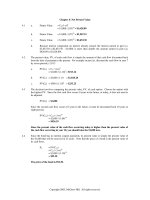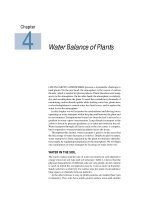Chapter 4 strategic sourcing
Bạn đang xem bản rút gọn của tài liệu. Xem và tải ngay bản đầy đủ của tài liệu tại đây (334.91 KB, 34 trang )
Chapter 4
Strategic
Sourcing for
Successful SCM
LEARNING OBJECTIVES
You should be able to –
• Describe the difference between purchasing and
strategic sourcing
• Describe how strategic sourcing plans are developed and
implemented
• Define and describe the terms green sourcing, VMI, JIT
II, in-sourcing, co-sourcing, and co-managed inventories
• Describe sourcing’s role in managing key supplier
relationships
MBA Nguyen Phi Hoang©2015_SCM
2
LEARNING OBJECTIVES
(Continued)
You should be able to –
• Describe the performance criteria used in assessing
suppliers.
• Describe how strategic supplier relationships can impact
the firm.
• Describe how a reverse auction/tendering works.
• Understand the importance of sharing the benefits of
strategic partnerships.
• Understand the strategic role played by the purchasing
function in developing & improving the supply chain.
MBA Nguyen Phi Hoang©2015_SCM
3
CHAPTER OUTLINE
• Introduction
•
•
•
•
•
•
•
Ethical and Sustainable Sourcing
Developing Ethical and Sustainable Sourcing Strategies
Supply Base Rationalization Programs
Ethical and Sustainable Supplier Certification Programs
Outsourcing Products & Services
Early Supplier Involvement
Strategic Alliance Development
MBA Nguyen Phi Hoang©2015_SCM
4
CHAPTER OUTLINE
•
•
•
•
(Continued)
Use of e-Procurement Systems
Rewarding Supplier Performance
Benchmarking Successful Sourcing Practices
Using Third-Party Supply Chain Management Services
• Assessing & Improving the Firm’s Sourcing Function
MBA Nguyen Phi Hoang©2015_SCM
5
Introduction
Sourcing - all of firm’s activities used to manage
external resources.
Strategic sourcing - managing the firm’s external
resources to support firm’s long term goals.
Drivers/ Key aims of Strategic Sourcing
Reduce costs & delivery cycle times
Improve quality & long-term financial performance
Focus on ethical and sustainable sourcing
MBA Nguyen Phi Hoang©2015_SCM
6
•
Why need focus on
ethics, sustainability or
enviroment?
Read article on page 102 and give conclusion
MBA Nguyen Phi Hoang©2015_SCM
7
Ethical and Sustainable
Sourcing Strategies
Business Ethics is the application of ethical
principles to business
Corporate Social Responsibility(CSR) is the
practice of business ethics
Ethical Sourcing is that which attempts to take into
account the public consequences of organizational
buying or bring about positive social change through
organizational buying behavior
MBA Nguyen Phi Hoang©2015_SCM
8
Ethical and Sustainable
Sourcing Strategies
(Continued)
Ethical Policies should include –
Determining where all purchased goods originated
and the manner in which they were made
Knowledge of the suppliers’ workplace principles
Inclusion of ethics as a performance rating
Independent verification of vendor/seller compliance
Report of supplier compliance to stakeholders
Provision of detailed ethical sourcing expectations to
suppliers
MBA Nguyen Phi Hoang©2015_SCM
9
Ethical and Sustainable
Sourcing Strategies
(Continued)
Sustainable Sourcing
Green purchasing is aimed at ensuring products or
materials meet environmental objectives e.g. waste
reduction, reuse and recycling
Sustainability is the ability to meet current needs of
the supply chain without hindering/limit the ability to
meet future needs in terms of economic,
environmental, and social challenges
Considers worker safety, wages, working conditions, human
rights
MBA Nguyen Phi Hoang©2015_SCM
10
Ethical and Sustainable
Sourcing Strategies
(Continued)
Sustainable Sourcing should seek to –
Grow revenues
New sustainable product introduction
Reduce costs
Increase resource efficiencies
Manage risk
Link brand to social consciousness of consumer
Build intangible assets
Build social and environmental responsibility
MBA Nguyen Phi Hoang©2015_SCM
11
Ethical and Sustainable
Sourcing Strategies
(Continued)
Framework for ethical and sustainable
sourcing strategy development
6 STEPS
MBA Nguyen Phi Hoang©2015_SCM
12
Ethical and Sustainable
Sourcing Strategies
(Continued)
Ethical and Sustainable Framework
Step 1:
Establish
policies
Step 2: Train and
implement
Step 3:
Prioritize
opportunities
Step 4: Develop
performance
measurement
systems
Step 5: Monitor
progress and
make
improvements
Step 6: Expand
focus to other
departments
Step 1 – Establish corporate
ethical and sustainable
sourcing policies
• Verifies top management support, establish a
vision and direction
• Enforce the importance of ethical and
sustainable sourcing and reduce confusion
MBA Nguyen Phi Hoang©2015_SCM
14
Step 2 – Train purchasing staff
and implement policies
• Ensure that buyers are skilled in environmental
and social consideration in sourcing
• Ensure user and suppliers understand why and
how purchasing decision are made
MBA Nguyen Phi Hoang©2015_SCM
15
Step 3 – Prioritize items based on
ethical and sustainability
opportunities and ease of
implementation
• Allow buyer to “pick low hanging fruit” to
provide evidence for successful strategy
implementation
MBA Nguyen Phi Hoang©2015_SCM
16
Step 4 – Develop performance
measurement system
• Measurement provide accountability and a way
to improve over time
• Should be reviewed periodically
MBA Nguyen Phi Hoang©2015_SCM
17
Step 5 – Monitor progress and
make improvements. Increase
use of green and fair trade
products
• Use performance measures to identify
weakness
• Step up efforts to develop better capability in a
firms and its supply base
MBA Nguyen Phi Hoang©2015_SCM
18
Step 6 – Expand focus to include
other departments
• Use the purchasing department’s success and
influence to grow awareness in the firm and
among customers
• Communicate successes and programes to
stakeholders.
MBA Nguyen Phi Hoang©2015_SCM
19
Supply Base
Rationalization
Programs
Supply base
rationalization (supply base
reduction or supply base optimization) is often
the initial supply chain management effort
Buyer-supplier partnerships are easier with a
rationalized supply base & result in –
Reduced purchase prices
Fewer supplier management problems
Closer & more frequent interaction between buyer &
supplier
Greater levels of quality & delivery reliability
MBA Nguyen Phi Hoang©2015_SCM
20
Strategic Alliance &
Supplier Certification
Programs
Supplier certification programs are used to
identify strategic supplier alliance candidates
Firms use in-house formal certification programs,
& most require ISO 9000 / 14000 or similar
certifications as part of the certification process
The use of ethical & environmental certification
is increasing
MBA Nguyen Phi Hoang©2015_SCM
21
Outsourcing Products
and Services
Outsourcing allows a firm to –
Concentrate on core capabilities
Reduce staffing levels
Accelerate reengineering efforts
Reduce management problems
Improve manufacturing flexibility.
Risks associated with outsourcing, include –
Loss of control
Production decisions & intellectual property
Increased reliance on suppliers
Increased need for supplier management
MBA Nguyen Phi Hoang©2015_SCM
22
Early Supplier
Involvement
Early supplier involvement (ESI) highly effective
supply chain integrative techniques
- Key suppliers become more involved in the internal
operations of the firm, particularly with respect to
new product & process design, concurrent
engineering & design for manufacturability
techniques
These above activities are called value
engineering which help the firm to reduce cost,
improve quality & reduce new product development time
MBA Nguyen Phi Hoang©2015_SCM
23
Early Supplier
Involvement
(Continued)
Vendor managed inventory (VMI) –
Suppliers manage buyer inventories to reduce inventory
carrying costs & avoid stockouts for buyer
From the buyer-firm’s perspective –
Supplier tracks inventories
Determines delivery schedules and order quantities
Buyer can take ownership at stocking location
From the supplier’s perspective –
Avoids ill-advised customer orders
Supplier decides inventory set up & shipments
Opportunity for supplier to educate customers about other
products
MBA Nguyen Phi Hoang©2015_SCM
24
Strategic Alliance
Development
Alliance development, an extension of supplier
development refers to increasing a key or
strategic supplier’s capabilities.
Supplier alliances result in better market
penetration access to new technologies &
knowledge, & higher return on investment
Alliance development eventually extends to a
firm’s second-tier suppliers, as the firm’s key
suppliers begin to form their own alliances.
MBA Nguyen Phi Hoang©2015_SCM
25









